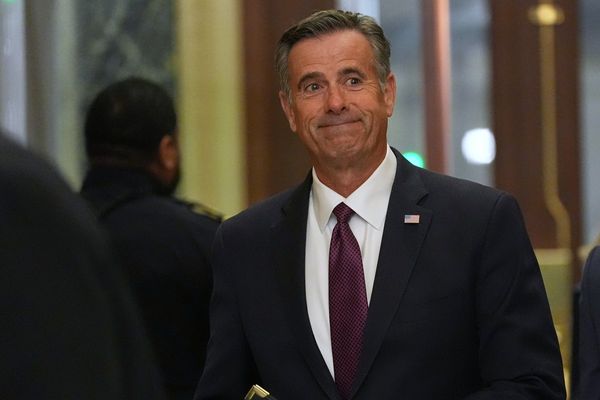
Victoria has a new governor, former Monash University vice-chancellor Margaret Gardner. In a ceremony in early August before Chief Justice Anne Ferguson, she affirmed her “faithful allegiance” to the king.
The new governor’s reception has been mixed. She got a good rap from the man who appointed her, Premier Dan Andrews, who enthused that her “strong values and passion for our state and its people will build upon the enduring work of our governors to date”. Julie Hare also wrote a gushing valedictory in The Australian Financial Review. Others have been less impressed, with criticism focused on Gardner’s public stance as a committed republican.
But relatively little attention has been paid to Gardner’s record at Monash University and before that at RMIT. That’s surprising, because in many respects that record is chequered. Most notably, as vice-chancellor of Australia’s largest university, Gardner presided over a significant episode of wage theft.
In June, in one of her last acts as vice-chancellor, Gardner published a long-form article on industrial relations in universities. The article went up on a Monash University digital publication called Lens, a commentary and current affairs channel that publishes op-ed-style copy from Monash academics. Content includes newsworthy research, lukewarm takes on current affairs issues — oh, and essays by the vice-chancellor.
The topic certainly is newsworthy. University industrial relations has moved quickly up the agenda in recent years, driven by a wave of admissions of wage theft totalling tens of millions of dollars and affecting tens of thousands of staff. University wage theft has featured prominently in recent years in parliamentary inquiries and media reports; the higher education sector is now on the Fair Work Ombudsman’s hit list of priority enforcement areas. The Albanese government has established a review of universities chaired by Mary O’Kane, whose interim report reserved special criticism for university boards for the underpayment spree.
So Gardner’s views were always going to be read with interest, inside the sector and in the corridors in Canberra. After all, her partner, Glyn Davis, secretary of the Department of Prime Minister and Cabinet, is one of the most powerful men in the federal government.
Interestingly, there was a crucial fact that Gardner didn’t mention in her Lens article: the wage theft on her own watch.
While Gardner was vice-chancellor in 2021, the then-boss of Australia’s largest university admitted to more than $8.6 million of underpayments to casual academic staff. Over six years, more than 2000 teachers had wages and entitlements withheld.
As an academic and union representative at Monash University, I had some thoughts about this. At a minimum, an essay by the vice-chancellor of a university should be a topic of open debate. But when I contacted the editors of Lens to submit a reply, it’s fair to say debate was not welcomed. An initial email asking to write a reply yielded a reply of “Lens does not publish content intended to articulate an entity’s perspective on current governance or corporate considerations”, which was a little strange, given Gardner’s piece is bylined “by Monash University President and Vice-Chancellor, Professor Margaret Gardner AC”. On the upside, I was told that “Monash Lens will consider all submissions”.
And so that what’s I did, sending Lens a 2000-word piece pitched as a reply to Gardner’s article.
Reader, you won’t be astonished to learn my submission was rejected. I was told “It does not meet the parameters mentioned in the previous email for our channel”, and when I asked for more details about the reasons for rejection, I was emailed by Monash’s impressively titled director of global communications and community management, who told me:
Lens is not the appropriate channel as the response was written from your position as president of Monash NTEU branch, and not from your academic position in the school of media, film and journalism. Lens is not the platform to debate matters related to Monash’s enterprise bargaining or its workplace relations matters.
Every academic is experienced in rejection, but this one says something interesting about the increasingly corporatised and stage-managed nature of communications in Australian universities.
In recent years, many universities have built glossy marketing “channels” including in-house newsrooms, podcasts and PR teams. Lens bills itself as “a window into the world of Monash University”, but the view through the window is rather distorted.
Lens is under the command of the university’s marketing team, and the free play of opinion and debate appears not to be a high priority. But in platforming the views of the former vice-chancellor while policing debate in reply, Lens also acted as a kind of management organ, or in-house content agency, for its CEO and president. It’s a “channel” where a vice-chancellor can publish a prominent article on workplace relations, while a submission from a staff member is rejected specifically because it is from a union representative.
So here goes. This is the piece I sent Lens in reply to my old boss, and Andrews’ new boss, the new governor of Victoria, Margaret Gardner. Hang on a sec — can you CC it to Government House?
In June, Monash University vice-chancellor Margaret Gardner penned a long essay for Monash Lens on workplace relations and insecure employment in Australian universities. The essay is a response to the Australian Universities Accord discussion paper, published in February.
Across more than 4000 words, Gardner canvasses the industrial landscape of what she rather delicately describes as the “inaccuracy of casual payments” in Australian universities:
While support for ‘sector-leading’ employment practices is important, the key concerns raised are specific, and reflect the current focus of much debate about what has been termed ‘wage theft’ and insecurity of employment in universities.
There is much to praise in Gardner’s article. She champions the good pay and strong workplace protections enjoyed by full-time ongoing academic and professional staff. She is surely right to observe that one driver for the casualisation of university workforces has been insecure public funding arrangements and the lack of proper public support for Australian university research. Finally, Gardner makes a welcome acknowledgment that “reducing casualisation is an important objective”.
A glaring omission
However, there is a glaring omission from Gardner’s article: the underpayments at her own institution.
Despite a detailed discussion of the industrial relations landscape in Australian higher education, Gardner somehow fails to mention the millions of dollars of underpayments that happened on her own watch. “What has been termed ‘wage theft’ “, as she writes, in fact includes millions of dollars owed to the staff who Gardner employs.
A casual reader of Lens would not know — because they aren’t told — that while Gardner was the president and vice-chancellor of Monash University, she presided over $8.6 million in underpayments to casual academics across more than six years.
Monash’s underpayment issues are current and ongoing. Last year, the National Tertiary Education Union issued writs in the Federal Court against the university, alleging further instances of widespread and systemic underpayments. The university denies these allegations and has launched its own lawsuit in the Fair Work Commission in an attempt to retrospectively rewrite Monash’s enterprise agreement, which, if successful, would defeat the NTEU’s underpayment claim. Monash’s application to vary the agreement was recently rejected in the FWC by deputy president Bell. The university is appealing the decision.
Curiously, none of this is mentioned in Gardner’s essay on “workplace relations and insecure employment”.
As a vice-chancellor with an academic background in industrial relations, Gardner’s interventions in the public debate should be welcomed. But academic debate should begin from a position of full disclosure. Eliding or ignoring the university’s admitted record of underpayment means readers don’t have all the information.
Nor is this only a matter for the governance of Monash. Gardner’s essay has already been cited by the Universities Accord interim report, so these evasions have entered into the public policy record.
Yes, uni workforces really are highly casualised
In her essay, Gardner is at great pains to point out that university workforces aren’t as casualised as people make out. For instance, she writes that:
There have been estimates that 31% of the academic workforce is in sessional or casual employment. Nevertheless, as the discussion paper outlines, 16% of the total university workforce is casual or sessional — below the proportion in the overall Australian workforce, which is estimated at 23%.
Unfortunately, some of the numbers that Gardner asserts don’t stack up. For instance, the 16% figure she cites is on a full-time-equivalent basis. But most casuals are, by definition, not full time. The available data on head counts shows much higher levels of casualisation. Gardner cites, but then dismisses, the careful figures compiled by University of Melbourne researchers Elizabeth Baré, Janet Beard and Teresa Tjia. Their data was compiled from official Department of Education figures, and there is little reason to doubt the veracity.
On these more appropriate measures, the higher education workforce is highly casualised. Monash’s own public disclosures, published on pages 68-69 of its 2022 annual report show that ongoing employment was only 46% of total staff numbers. Casual employment by headcount was as high as 29% in March 2022 — considerably more than the overall Australian workforce.
The interim report of the Universities Accord sums the situation up bluntly: “The teaching workforce is highly casualised.”


Gardner also claims that:
At Monash, there are three distinct groups of academic casuals or sessionals:
- Industry experts, typically with a career and employment outside the university, who comprise some 40% of sessional academics;
- Current Monash PhD students, who account for a further 29% of sessionals;
- The remainder of sessional academics, about 30%, who are likely to be seeking more secure employment, including as an academic.
As with those on fixed-term contracts, these three categories are not all experiencing insecurity of employment similarly.
Gardner does not provide a citation for these figures. As the university doesn’t survey its own staff about their outside work, it’s hard to know how Gardner could arrive at this estimate.
There is a big question hanging over any estimate of what the university calls “industry experts”: many casual academics hold multiple jobs.
Casual academics who happen to be working at another university or holding down a second or third job in retail or hospitality would not be expected to claim the tax-free threshold at Monash. Further, the withholding declaration could easily be out of date, as not many employees update their withholding details after commencing employment. An employee’s tax declaration tells us nothing about whether someone is an “industry expert”, and simply can’t be relied on for that assertion.
When pressed, the university admitted it had not conducted any formal survey of casual staff about their employment conditions, or even talked directly to any casual staff members about their experience of working at Monash. Nor would the university provide any further breakout of the numbers beyond the figure of 40%. In a university full of social scientists, this is a surprising admission.
Even if we accept the university’s own figures, the numbers do not paint a rosy picture of employment security in Gardner’s workforce. Less than half of Monash University staff members enjoy ongoing secure employment, and between 16% and 29% of Monash staff members are casuals, with no entitlement to sick leave, and no security of tenure.
Is paying academic staff really that complex?
The nub of Gardner’s argument is stated this way:
The employment conditions currently applied in Australian universities are … the product of years of negotiations between universities and the relevant unions, principally the NTEU. They’ve produced, as noted above, strong employment protections for those in continuing employment.
They’ve also produced complex systems for casual academic staff, enshrined in EBAs, in which both the hiring of casuals and the decisions on workload allocation and payments are dispersed across many hundreds or thousands of ‘supervisors’ and small organisational units, such as departments or schools within faculties.
This leads to systematic difficulties in interpretation of payment schedules, and therefore payment accuracy, that have exacerbated issues for the employment and payment of those in insecure employment.
There are a number of things to say about this claim. The first is that phrases like “complex systems for casual academic staff” and “payment accuracy” are doing an awful lot of work.
It is true that many different parts of Monash University hire casual academics. A better description of this arrangement is that it is “distributed”, in the sense that individual unit coordinators are typically the initiators of decisions to hire TAs, and that this may indeed involve lots of different courses and teaching departments.
That doesn’t mean the university is not in control of academic payment. Contrary to Gardner’s assertion, Monash has a relatively systematised process for hiring casual academics. It is codified in straightforward policies and processes. The university has developed a timetable of casual session descriptors based on the enterprise agreement, which the university negotiated and signed.
How complex are the “systems” for hiring casual academics really? As noted, employment conditions for casual academics at Monash are governed by the enterprise agreement. The most important bit is called Schedule 3, which defines the different types of casual teaching sessions, like tutorials and lectures.
Schedule 3 runs to less than three pages. It is not, in any legal or accounting sense, a particularly complex document; nor has it changed in any substantive way for the past decade. Other parts of the EBA that deal with casual academics manage to outline pay and working conditions in just a few scattered paragraphs. It is not immediately apparent why paying casual academic staff is any more complex than, for instance, enrolling tens of thousands of domestic and international students across thousands of academic courses and multiple campuses.
Why complexity is no excuse for underpayments
A more important question is whether complexity is a valid excuse for underpaying staff.
In the 2010s, when entrenched wage theft in Australia’s restaurant and hospitality sector came to light, celebrity chefs like George Calombaris and Neil Perry complained that staff underpayments were the unintended results of the complexity of awards and enterprise agreements. Public anger showed that the community did not buy this argument.
Regulators aren’t buying it either. As outgoing Fair Work ombudsman Sandra Parker noted in an interview in April, for large businesses “It’s pretty hard to swallow that you don’t have the resources to address that complexity.” In a submission to the Universities Accord, deputy Fair Work ombudsman Rachel Volzke noted: “Universities should ensure that their corporate governance structures and models elevate workplace relations compliance to the same status as compliance with other duties.”
Employment Minister Tony Burke rebutted the complexity argument in a speech to the National Press Club in February.
People say, ‘Oh, it’s too complicated.’ People are used to the fact you have to comply with tax law. You make sure you get your tax return right and you get some advice to make sure you’re getting it right. People are used to the fact that you have to comply with planning law. If you’re undergoing a major build, you get some advice to get your planning law right. There’s been an attitude for too long that you can second-guess your employment law.
Monash University is a $3 billion organisation with access to sophisticated legal and accountancy advice; its preferred provider of employment advice is big law firm Clayton Utz. This university teaches employment law, hosts a centre for commercial law and regulatory studies, and supports a dedicated department of management within the Monash Business School. More than 500 staff work in Monash HR.
Lots of things are complex: heart hospitals, ARC centres for excellence, multi-partner commercial research contracts. As an institution, Monash seems to manage such arrangements with conspicuous success. The contention that Australia’s largest university finds paying its casual staff too complex is unconvincing.
Staff and students deserve better
Monash makes much of its public mission and runs expensive marketing campaigns about the university’s commitment to positive change. “Impact 2030” also commits the university to the “highest international quality” of teaching and research.
But a university can’t deliver high-quality teaching if doesn’t pay its academics properly — as the NTEU alleges is still happening. Strategic commitments to “thriving communities” should also include complying with national employment law. Finally, debate and discussion about this important issue should also be open and honest — which includes an open discussion of the university’s poor track record.
Gardner can be proud of many achievements while vice-chancellor of our university. Our next university leader, however, will have to grapple with her legacy of high levels of job insecurity and ongoing problems with paying staff what they are lawfully entitled.
Disclosure: Ben Eltham lectures at Monash University, where he is the president of the National Tertiary Education Union branch.







